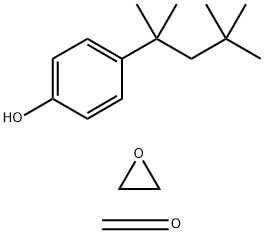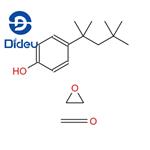Description
Tyloxapol is a non-ionic liquid polymer of the alkylaryl polyether alcohol type. It has a wide range of uses as a surfactant (primarily for bronchopulmonary studies and drug delivery systems), an animal model inducer (used for induction of hyperlipidaemia in animals), and a reagent for biological studies (including studies of its mechanism of protection of macrophages against endotoxins and potential cytotoxicity).
Chemical Properties
clear to hazy yellow to amber viscous liquid
Uses
anthelmintic, hepatotoxic
Uses
Tyloxapol, is a nonionic liquid polymer of the alkyl aryl polyether alcohol type. It is used as a surfactant to aid liquefaction and removal of mucopurulent (containing mucus and pus) bronchopulmonary secretions. Tyloxapol also blocks plasma lipolytic activity.
Definition
ChEBI: Tyloxapol is a polymeric compound resulting from the reaction of 4-(1,1,3,3-tetramethylbutyl)phenol with formaldehyde to give a chain in which 6-8 molecules are linked together by CH2 groups ortho to the phenolic hydroxy groups, which have then undergone reaction with oxirane to give polyoxyethyleneoxy moieties, Ar(OCH2CH2)xOH, where x = 8-10. A nonionic liquic polymer, it inhibits lipoprotein lipase and hence clearance of triglyceride from the plasma, so is used to induce hyperlipidaemia in test animals. Also used as a surfactant to aid liquefaction and removal of mucus- and pus-containing bronchopulmonary secretions. It has a role as an inhibitor, an excipient, a surfactant and an apoptosis inducer.
Manufacturing Process
Srep 1: Into a 3-necked flask equipped with thermometer, mechanical
agitator, and reflux condenser was charged the following: 412 g of α,α,γ,γ-
tetramethylbutylphenol, 162 g of a 37% aqueous solution of formaldehyde,
and 27.6 g of water. The mixture was agitated and heated to a temperature of
90°C. At this point, 246 g of oxalic acid and 0.92 g of Twitchell's reagent
dissolved in 10 g of water were added. While being agitated, the reaction
mixture was refluxed for 6 hours. 200 g of water and 384 g of toluene were
added, and refluxing was continued for an hour.
Agitation was stopped and the contents of the flask were removed to a
separatory funnel. The aqueous and resinous layers were separated and the
solvent was removed from the resinous layer by vacuum distillation. After the
removal of the solvent, heating at a reduced pressure of 1.5 to 2.5 mm and at
a temperature of 245° to 250°C was continued for 4 1/2 hours. The
condensate then had a viscosity of 4.0 poises when measured as a 60%
solution in toluene and, on cooling, solidified to a brittle mass.
Step 2: A mixture of 118 parts of the product of Step 1, having hydroxyl
number of 260, 2 parts of solid NaH, and 100 parts of toluene was heated to
125° to 150°C in an autoclave. Ethylene oxide was added slowly over a period
of 2 1/2 hours until 261 parts of ethylene oxide were absorbed. This
corresponds to 11 mols of ethylene oxide per mol of phenol in the product of
Step 1. The toluene was then removed by steam distillation and the water by
vacuum distillation at 10°C. The product was obtained as a viscous paste
having a corrected hydroxyl number of 97. It was readily soluble in water and
had marked detergent properties.
brand name
Superinone (Sterling Winthrop).
Therapeutic Function
Bronchodilator
General Description
Tyloxapol is a biocompatible surfactant
Mechanism of action
Tyloxapol, when injected IP, blocks plasma lipolytic activity, and thus the breakdown of triglyceride-rich lipoproteins. It has also been shown to be inhibitor of lipoprotein lipase, thus preventing triglyceride uptake.




